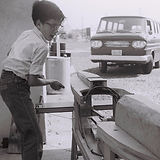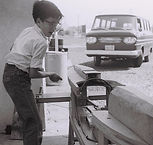Production Design is not an obvious career decision, and often the road to becoming a production designer is a winding one. Our colleagues share their stories about moments of revelation and the factors that lead them to choosing their profession.

David Wasco
"A series of experiences and mentors influenced my choices and instilled an appreciation and love of design and the process."

Annie Spitz
"I had never felt such a sense of pride and joy seeing my work on screen, appreciating every design choice I'd made, and knowing I did it all myself."

Hannah Beachler
"I did the production design for this really tiny horrible show and I was like yeah, I want to do this forever."

Zoe Sakellaropoulo
"The notion of “home” never took form but made me curious to look into the worlds of other people."
November 18th, 2017
What was your 'AHA' moment in deciding to become a production designer?

David Wasco
David Wasco and set decorator Sandy Reynolds-Wasco are a husband and wife duo who have worked together on more than 20 films in the past 25 years. They have collaborated with some of the most talented filmmakers today, including Quentin Tarantino, Wes Anderson, Michael Mann and recently Damien Chazelle on La La Land, for which they won the 2016 Academy Award for Best Achievement in Production Design.
For as long as I can remember I have always been interested in watching movies. As a kid growing up in suburban New Jersey, TV was a big thing but I also had access to large scale movie theaters. In fact, the Baroque Rivoli theater boasted the largest chandelier in the world! (Guinness Book of Records). Viewing the first Cinerama movies, James Bond, schlock and "B" horror movies, etc. had me hooked from a very early age.
I'm lucky as well to have been brought up in a modernist household with visual parents. They raised 3 sons as free thinkers and Artists, encouraging us to be creative in a flexible, non linear way. A big influence was my father who was an Abstract Expressionist painter, theater Set Designer, still photographer, hand letterer, ceramicist and metal sculptor. My father was a Renaissance man in a true sense of the word. He was an outstanding still photographer who had Bernice Abbott as his photography teacher and worked alongside Arnold Newman as his assistant post second world war. As a fellow ceramic artist he hosted Bernard Leach at our house.
My Father received an offer to teach Art and Theater Set Design at Bennington High School in Bennington, Vermont where he then moved our family. I was the first class to attend Bennington's brand new High School, designed by Benjamin Thompson from The Architects Collaborative. A memorable highlight while in high school was a one-on-one meeting with Designer George Nelson that was set up for me personally through my father and Benjamin Thompson. We talked for an hour. Mr. Nelson asked what I wanted to do with my life...
As early as 2nd grade, I recall wanting to become an Architect, but watching movies remained a serious pastime. Later in High school, making 8mm movies became a passion. I never really thought of Production Design specifically, but went at it making abstract short movies. The Art Direction for these projects came along unconsciously through the process of making each film.
After high school, I wanted to follow in my fathers footsteps and attend The Cooper Union School in N.Y.C. I was not accepted after my first attempt with their entrance exam. Thinking I'd try again the following year, I ended up employed at various window display jobs in N.Y.C. and eventually gaining a corporate job overseeing visual merchandising at a retail store called Design Research, a boutique 10 store chain owned by Benjamin Thompson. That company moved me around the country from San Francisco to L.A., then finally to Cambridge, Mass. where I met my wife Sandy Wasco. While working at D/R, I met and had conversations with Ray Eames, Mrs. Dione Neutra, Fashion Designer Rudi Gernreich, Architect William Turnbull, Armi Ratia the founder of the Finnish Fabric Co. Marimekko.
It was not until the early 1980's that I decided to pursue movie Art Direction full time, and made a decision to move back to southern California. Through a friend's tip, I interviewed for a position in the Art Department on the first "Beasmaster" directed by Don Coscarelli. 1980 was an odd time in Hollywood. There was a Writers / Directors strike and we were one of the only full scale independent features happening in an unusually quiet city.
The position I held was "Assistant to the Production Designer" where I functioned as a combination Art Department Coordinator / Assistant Art Director. Although I had no formal training, I happily performed my tasks and was employed for almost a year. This entry feature film gave me the opportunity to watch the process from the inside and make valuable connections with fellow Art Directors that I remained in touch with, including the late Tom Sanders and Michael Minor. I also got to watch and interface with the Cinematographer John Alcott, who was working on his very first US movie. Mr. Alcott was my hero and DP on some of my very favorite Stanley Kubrick movies. Movies that were a great influence.
A stint at the indy set building company "Design Setters" allowed me to make more Art Director connections, Leon Ericsen, Michael Erler.... But, at the same time offered me the opportunity to interview and land small art direction jobs that allowed me to amass Production Design credits.
Pure luck would have it connecting me with a few directors that carried me along to Design their early works. Gregory Nava, Quentin Tarantino, Wes Anderson.... On my first outing with Wes, he put me alongside another one of my hero / mentors, Polly Platt who was Producer on "Bottle Rocket".
There really was no "ah-ha" moment when I decided to pursue Production Design, but a series of experiences and mentors influenced my choices and instilled an appreciation and love of design and the process.

Hannah Beachler
Hannah Beachler most recently designed for director Ryan Coogler on Marvel’s Black Panther. She
previously collaborated with Coogler on the films Creed and Fruitvale Station. She also collaborated with director Barry Jenkins on the 2017 Best Picture Oscar-winning film Moonlight and Beyoncé’s stunning visual concept album Lemonade, for which she won the 2017 Art Director’s Guild Award for Excellence in Production Design.
After majoring in fashion design in undergrad, I started helping friends out with their music videos. Eventually, I went back to school to study film, initially interested in becoming a director before a classmate asked for my help with the set on a Lifetime project they were working on. That was it. I did the production design for this really tiny horrible show and I was like yeah, I want to do this forever.

Annie Spitz
Annie Spitz is a LA-based Production Designer. Her credits include the Night Before, Playing House and 50/50.
Although I’d always been interested in filmmaking, it wasn’t until I enrolled as a fellow at the American Film Institute that I realized I wanted to be a Production Designer. Oddly enough, I attended AFI as a
producer. The first year at AFI students make three short films, and everyone wears several hats to get things done. Producers are responsible for certain things that they wouldn’t normally do in the “real world,” so in addition to learning how expertly maneuver two shopping carts fully-loaded with craft service around Costco I also got to find all the locations for my films. Producers had to be incredibly resourceful since we were usually trying to get locations for free and people in LA are terrifically savvy about location fees. We had to cast a wide net and really think about how we could shoot a
location like a seedy Hollywood bedroom for an opulent Paris Hotel room with minimal dressing…because we didn’t have money for that either. We got to think like designers and I loved it.
The opportunity to influence design didn’t stop there. At AFI each team is made up of 5 students, a Producer, a Director, a Cinematographer, an Editor, and sometimes, a Production Designer. The
Production Design discipline had fewer students enrolled so there weren’t enough designers to go around. We often had to pitch in to cover the PD needs and I was always happy to take on these
responsibilities. I loved visiting prop houses, reimagining the battered flats on the stage and shopping for furniture at thrift stores. I started collecting often called upon items for my first kit and learned the ancient art of refolding Ikea curtains so they could be returned.
Having found so much pleasure in these elements of the job I wanted to take the next logical step: designing a film. I partnered with a director for her 3rd short and got the chance to build my first real
set. I agonized over every element of the design and learned things I still think about as I do my job today. Low-budget filmmaking is physically and emotionally grueling but I had never felt such a sense
of pride and joy seeing my work on screen, appreciating every design choice I’d made, and knowing I did it all myself. I was hooked.
After that film, I decided to drop out of the Producing program so I could focus on what I was sure I was meant to do: be a Production Designer. I spent the following year designing as many of AFI colleagues’ thesis films as I could and then went on to design several of their features. I’ve never looked back.

Zoe Sakellaropoulo
After obtaining a degree in history at the American College of Greece, Zoe attended the National Theatre School of Canada graduating in Design. Her first credit as Production Designer was the indie feature "Waking the Dead" starring Billy Crudup and Jennifer Connoly. Since then Zoe has worked on numerous feature films, mini-series events and TV series.
Having grown up with parents in separate continents, many moves and schools later, turned me into a master observer. The notion of “home” never took form but made me curious to look into the worlds of other people. By the time I was eight years old, I had written plays and puppet shows on this subject, performed them and turned a giant secluded rocky beach into my private village with its own shops.
My mother, a journalist, had remarried a documentary filmmaker, himself from a prominent film family who enlisted all of us to work for the family business . Their world was rooted in reality but mine remained a rather dreamy fictional one…
It was not until I watched “Interiors” by Woody Allen that I understood the power of Production Design. Mel Bourne’s monochromatic vision of a controlled and restrained order spoke to me as much as the other characters in the film. I was completely moved by this experience and knew then what I wanted to do with my life.
